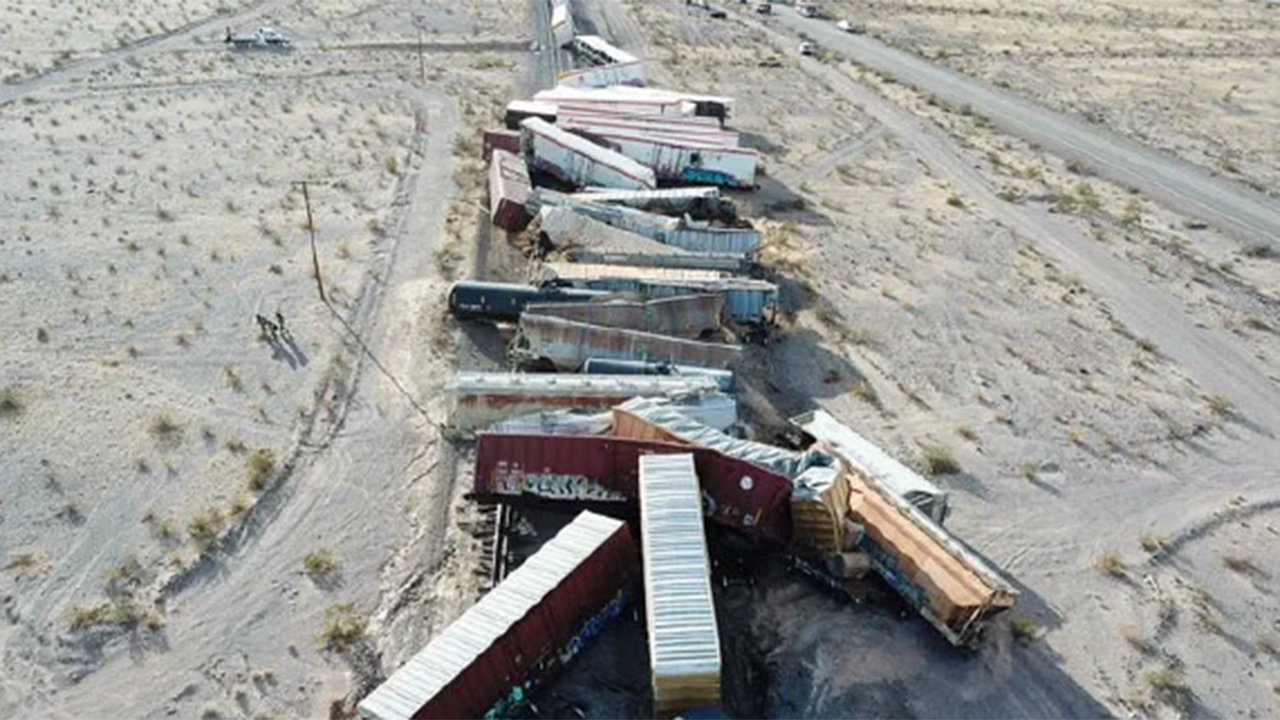
WHITE PAPER: Management of In-Train Forces – Challenges and Directions, First Addendum
Written by Grady C. Cothen Jr., Federal Railroad Administration (ret.)
BNSF derailment at Ludlow, Calif., March 21, 2021. Cause: FRA H504, buffing or slack action excessive, train makeup
The June 2022 White Paper supplemented here was devoted to “management of in-train forces.” This is an issue for trains of virtually all lengths and tonnages, but longer trains present special challenges. Both train makeup and train handling are critical. These challenges can be mitigated with use of DPUs (distributed power units), properly networked using radio telemetry. However, DPUS are still not being employed consistently some seven years into Precision Scheduled Railroading (PSR). Further, as the National Academy of Sciences (NAS) committee on very long trains (VLTs) was advised in March of 2023, not all railroads are even using the most advanced radio communications features available for distributed power, let alone fully mastering the use of repeaters.
However, what has happened is that, even if DPUs are fully employed (e.g., mid-train and rear) there is still the temptation to build trains with segments that exceed prudent length and are not properly blocked. In grade or undulating territory, this can result in train air brakes showing off their faults—the reason the writer has described them as the “limiting factor” in responsible train marshalling and, particularly, automated train operations. Partial automated operations, using train energy management systems (TEMS), have not yet mastered air brakes, so they are normally cut out in grade territory.
Issues with TEMS and other on-board train technology continue to confound our understanding of accident outcomes. During the period the White Paper has been in revision, TEMS, and positive train control (PTC), have been integrated on some locomotives—but not all. Transitions from TEMS operation to manual operation seem to present challenges. De-skilling of locomotive engineers may be occurring in many circumstances, given reliance on TEMS and dynamic braking (to the exclusion of air brakes) and due to the limited time available for training in an industry barely able to handle the remaining traffic. Major railroads engaged in extensive interchange of full consists and use of various interline arrangements still show no outward sign of cooperating with respect to train marshalling principles.
This Addendum (downloadable below): Version 3.0 of the White Paper was completed in June 2022, using the latest published accident reports as of that time, which brought us through February 2022.
As the research for this update was concluded, reports were available through the end of 2022; in the meantime, FRA has published some accident investigation reports of interest. Accordingly, this Addendum provides revisions and additions to Appendix B of the White Paper. This addendum has been circulated for review to a wide range of industry experts. Only a few responded, but those who did contributed significantly to this publication.
Being a single individual, the writer has continued to focus on events involving the four largest Class I railroads. You will note that two of those railroads are featured prominently in the Appendix. I have necessarily applied some judgment in the selection of events, because my focus has been management of in-train forces, a problem writ large in this era of PSR (or whatever alternate moniker may have, by now, been selected).
DOWNLOAD THE WHITE PAPER FIRST ADDENDUM:

Retired rail transportation consultant Grady C. Cothen Jr. retired in 2010 from the Federal Railroad Administration after 36 years in various positions: Deputy Associate Administrator for Safety Standards and Program Development (1994-2010); Associate Administrator for Safety (1991-1994); and Special Assistant to the Chief Counsel for rail safety, labor protection and asset sale projects (1975-1991). Prior to that, he served as a trial attorney in the Enforcement Division of the FRA Office of Chief Counsel. Cothen was also Acting Associate Administrator for Policy from 1986-1988, where he provided executive direction for economic, financial and traffic analysis and freight policy studies, including recommendations for Departmental positions in rail proceedings before the Interstate Commerce Commission. Cothen holds a J.D. from Georgetown University Law Center and a B.A. in Government and History from Oklahoma Baptist University. The opinions expressed here and in the attached paper are his own.



